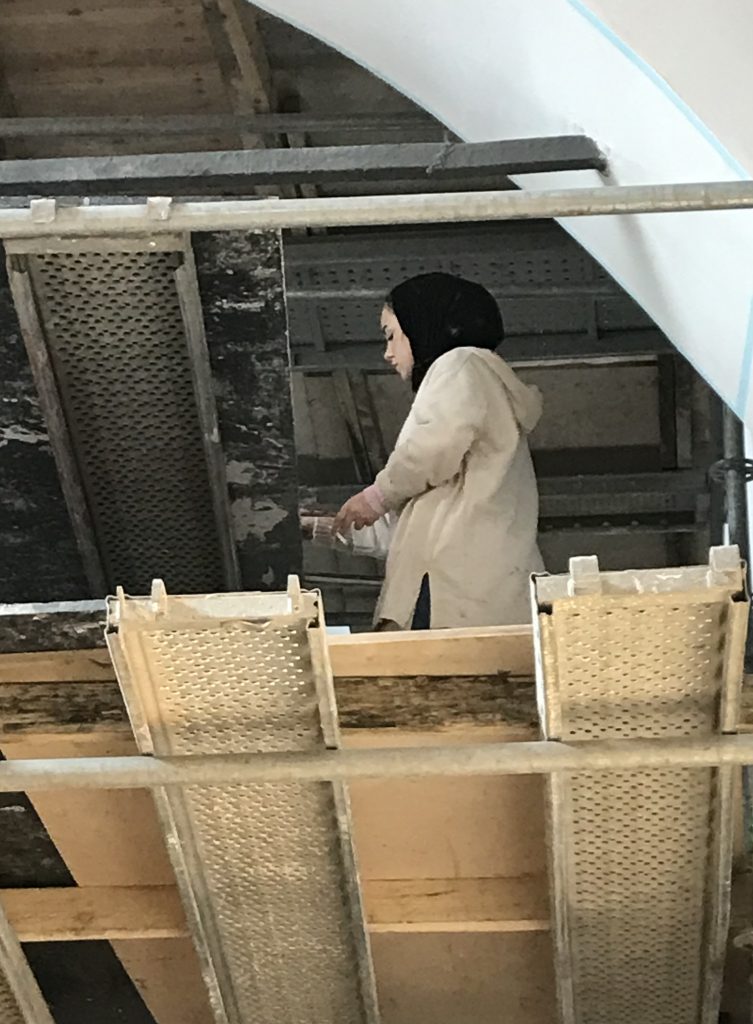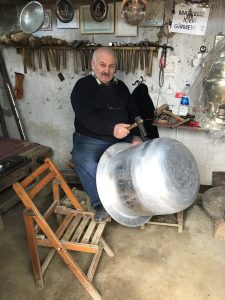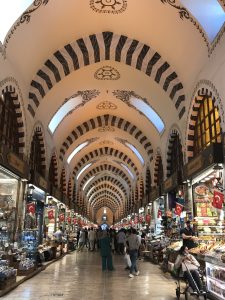 Biggest bazaar in İstanbul
Biggest bazaar in İstanbul
Opening hours: 8.30am to 7pm. Closed Sundays and first days of Ramazan and Kurban Bayramı
One of the must-see fixtures on most visitors’ itineraries is the Kapalı Çarşı (Covered or Grand Bazaar) which has been serving shoppers since the mid-15th century when work on it started during the resign of Mehmed the Conqueror. Then it is thought to have had about 500 shops. Now there are more like 4,000 separate shops amid its warren of narrow alleyways.
This is a place you’ll probably love or loathe, depending on your enthusiasm for shopping of a sometimes rather hassley nature. There’s no doubt that most of what’s on offer in the Grand Bazaar these days is aimed fair and square at the assumed tastes and wallets of tourists. There are, however, some parts of it that still attract locals as well, not least the street of gold shops where they come to buy coins and jewellery to give as gifts at weddings, circumcisions and other parties.
Although it’s less so today than it used to be, areas of the bazaar do still have their specialties such as jewellery, carpets or goods imported from the wider Turkic world.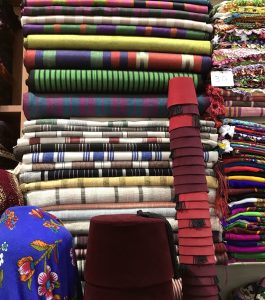
If at all possible, try and get up onto the roof of the bazaar for spectacular views over the surrounding area including of its many domes and brand-new roof tiles.
Restoration of the bazaar has been ongoing for years but shouldn’t affect your visit. A bigger problem is that most visitors have only limited time to get to grips with it when really the best way to handle it is to come once, preferably early in the morning, to get the lie of the land and decide what interests you before coming back later for the serious business of bargaining.
And, yes, this is one of the few remaining places in Turkey where bargaining (pazarlık) is still essential – pay the first price quoted and you will certainly come unstuck.
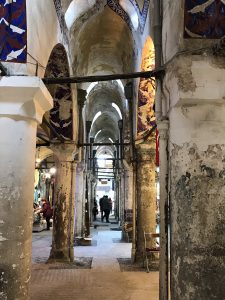 Inside the bazaar
Inside the bazaar
Today the bazaar is largely covered over although originally it would have consisted of a series of hans with stalls framing central courtyards, most of them specialising in one particular type of product. Between the hans would have been alleys lined with dolaps (cupboards) where the stallholders would sit all day waiting for customers. The names of many “streets” in the bazaar still recall some of the lost trades – for example the street that is now filled with gold and jewellery shops is called Kalpakçılar Caddesi after the men who used to sell kalpaks or fur-lined caps here.
Although there are many entrances into the bazaar, the two main approaches are from Beyazıt Square or from beside the Nuruosmaniye Cami at Çemberlitaş. In both cases you will find yourself on Kalpakçılar Caddesi , although if you enter through the Nuruosmaniye gate you will come in beside what was once the Sandal Bedesten , a part of the bazaar where a luxury fabric from Bursa called sandal used to be sold (it’s now occupied by a branch of the Salt Bae restaurant chain, Nusr-et Steakhouse). From Beyazıt Square there are two gates into the bazaar. The Çarşı Kapı leads to Yağlıkçılar Caddesi (Street of the Handkerchief-Sellers), while the Beyazıt Kapı comes in close to the Bodrum Han.
These gates are all on the southern side of the bazaar but you can also enter from the northern gates which may be somewhat quieter. You can, for example, enter through the Mahmutpasa Kapı which opens onto Aynacılar Sokak (Street of the Mirror-Sellers), close to the pretty Zincirli Hanı; or from the Mercan Kapı which opens onto Kuyumcular Caddesi (Street of the Jewellery-Sellers). These gates are on the eastern side of the bazaar but the most interesting part is on the western side, accessible via the Lütfullah Kapı (beside the Sahaflar Çarşısı) or the Örüçüler Kapı which opens on to Yağlıkçılar Caddesi (Street of the Handkerchief-Sellers).
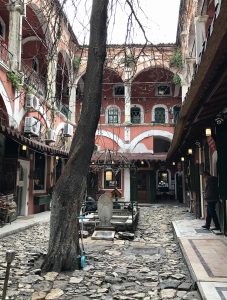 Once inside, you might like to seek out the Zincirli Hanı which is still cobbled and tree-shaded, and occupied by several long-lived carpet shops. The brick-vaulted İç (Cavehir) Bedesten, right in the centre of the bazaar, is filled with antique shops and surrounded by heavy, lockable gates. The oldest part of the bazaar commissioned by Sultan Mehmed II in 1461, it was originally where male slaves were bought and sold. The Cebeci and İç Cebeci Hans near the Lütfullah Kapı are particularly atmospheric.
Once inside, you might like to seek out the Zincirli Hanı which is still cobbled and tree-shaded, and occupied by several long-lived carpet shops. The brick-vaulted İç (Cavehir) Bedesten, right in the centre of the bazaar, is filled with antique shops and surrounded by heavy, lockable gates. The oldest part of the bazaar commissioned by Sultan Mehmed II in 1461, it was originally where male slaves were bought and sold. The Cebeci and İç Cebeci Hans near the Lütfullah Kapı are particularly atmospheric.
Particularly quirky is the Çukur Kule (Tower in a Hollow), a two-storey wooden booth with a domed roof that stands near the Mahmutpaşa Kapı at the lowest point (çukur) of the bazaar. A circular staircase leads to the upper floor which apparently served as a haremlik (secluded area) for female shoppers. Later the downstairs served as a police station while the upstairs was a lookout post for the fire brigade. Finally the downstairs became a pudding shop in the days when such things were fashionable. Today a jewellery shop occupies the ground floor while the upper floor is inaccessible.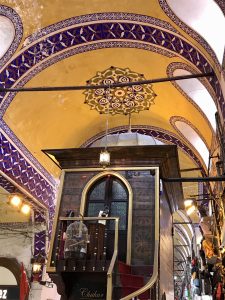
Eating and drinking
The Bazaar is a world within a world and accordingly has plenty of places to eat catering to all budgets which means that you won’t have to leave to find lunch. There are also places to change money. And of course toilets. There is also a small mosque for those who want to pray during their visit.
Around the bazaar
Close to the Nuruosmaniye Kapı on the eastern side but overlooked by most visitors, the Mahmut Paşa Cami dates back to 1462. It’s well worth visiting not just because it was built less than ten years after the Conquest but because the tiled tomb of the great grand vizier Mahmut Paşa behind it is a one-off in İstanbul and looks as if it has somehow strayed from Central Asia.
Just inside the gate is the magnificent Nuruosmaniye Cami, a work of the 18th century commissioned by Sultan Mahmud I in 1748 and designed incorporating aspects of western architecture.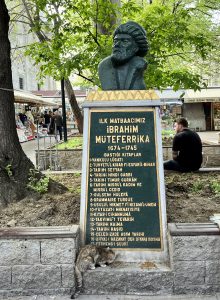
On the western side of the bazaar the Sahaflar Çarşısı is really a continuation of it, the sale of second-hand books flowing out into a separate courtyard entered through the Hakkaklar Kapı, the Gate of the Engravers. Once upon a time it really was a great place to come for second-hand books although these days it mainly sells textbooks aimed at the students of nearby Istanbul University. At the far end a bust of İbrahim Muteferrika (1674-1745) commemorates the man who brought the first printing press to the city in 1727.

The han district
To the north of the bazaar a tight-packed labyrinth of narrow streets dotted with more hans sprawls all the way downhill to Eminönü.
If you leave the Bazaar via the Örüçüler Kapısı the road leads straight down to the Golden Horn along Uzunçarşı (Long Market) Caddesi. If instead you divert east along Çakmakçılar Yokuşu you will pass the battered facade of the Büyük Valide Hanı, commissioned in 1651 by Kösem Sultan, the mother of Sultans Murad IV and İbrahim, and one of the most powerful of Ottoman women during the period sometimes called ‘the Sultanate of Women”. With three courtyards, each enclosed behind heavy metal gates, this is the larges han in İstanbul. In the centre of the largest courtyard is a small mosque which was originally built for the city’s Shiite community and was once the centre of bloody celebrations for Ashura, banned by Atatürk. Writers visiting in the 19th-century have left vivid descriptions of it.
Right next door to the Büyük Valide Hanı is the equally venerable and equally battered Sümbüllü Hani (Hyacinth Han). Facing these two hans are the Kücük Yeni and Büyük Yeni hans. The Küçük Yeni Han was commissioned by Sultan Mustafa III in the 18th century and has a small mosque and minaret on its roof despite its dilapidated state. Look out for the birdhouses on the side facing Mercan Caddesi. Mustafa III also commissioned the Büyük Yeni Han (1764) which is the second largest in the city and once have a 100-metre-long courtyard, now divided in two.
If you turn eight beside the Büyük Yeni Hanı you’ll see the Kürkçü Han (Furriers Han), which is thought to have been the oldest Ottoman han, dating back to the 15th century when it was commissioned by the grand vizier, Mahmud Paşa. If instead you turn left Fincancılar Sokak will take you straight down to Mısır Çarşısı (Spice Bazaar), passing by the Leblebici Hanı, the Marpuççılar Hanı and the Sabuncu Hanı.
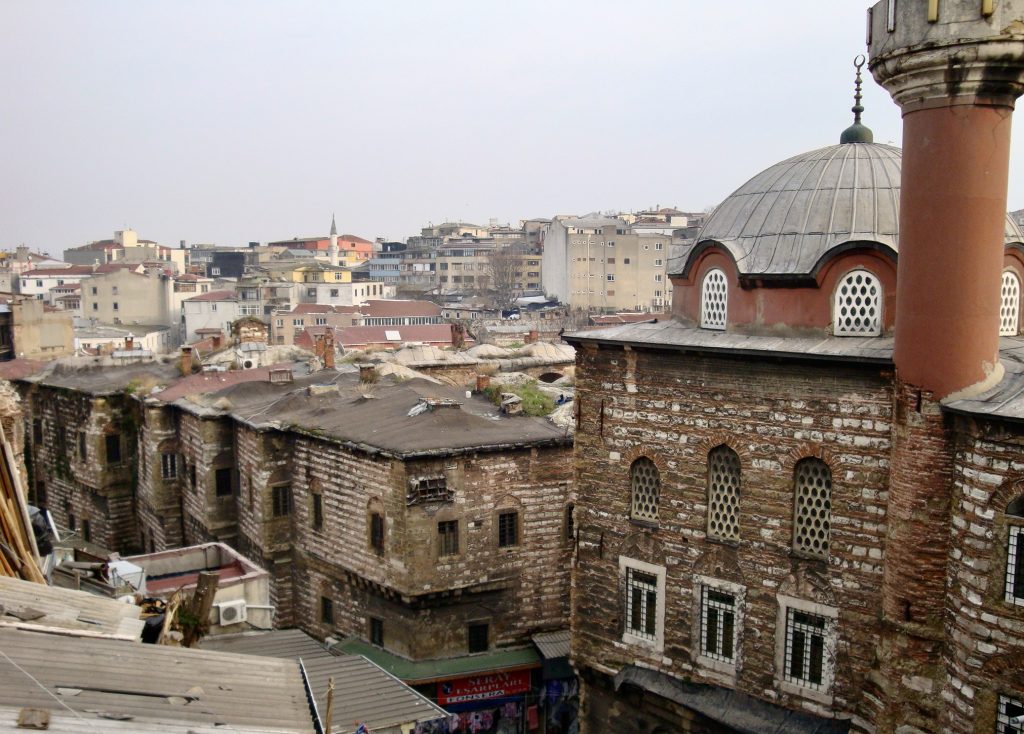
Transport info
Kapalı Çarşi is served by the T1 tram from Sultanahmet with stops at Çemberlitaş and Beyazıt convenient for accessing it.
Nearby areas
